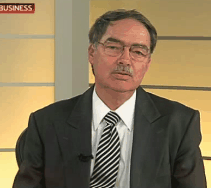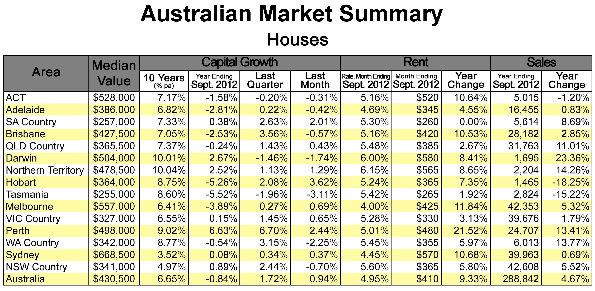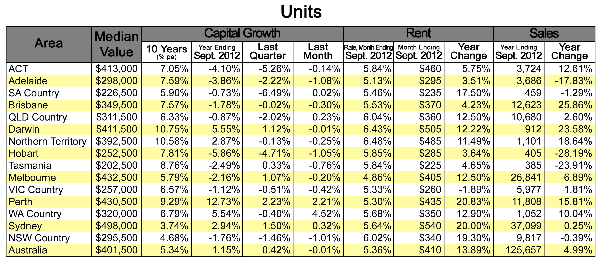
Following Australian Property Monitor’s lacklustre result last week for the September quarter, Residex has released its house and unit price results for the month of September. According to Residex, house prices nationally rose by 0.94% over the month, although results were mixed across the capital cities:

Results were worse for the unit market, with prices essentially flat (-0.01%), again with mixed results across the capitals:

As usual, the most interesting aspect of Residex’s release is John Edward’s commentary on the market. This month Edwards outlines why he unconcerned about the emergence of a house price bubble, as housing affordability is still relatively poor, consumer confidence is low, and the employment market is deteriorating:
The improving market and the interest rate cuts have led to suggestions that this could be the makings of a housing bubble. Residex does not believe this is likely for the following reasons:
1) Affordability is still not terrific in the major capital cities, even with the interest rate reduction. In the table ‘Affordability’, the position is presented. The data is based on the current median value of properties with consideration given to the rate cut, an assumed household tax rate of 17.2%, a net deposit of 20% after all purchase costs are paid, and the home loan interest rate is 5.75% pa effective. Remaining cash flow, after tax, for the typical family after making loan repayments is also displayed.
In my view, reasonable affordability is achieved once the percentage of loan repayments is less than about 35% of after tax income. This suggests that the unit market is affordable, the house and land market in Melbourne, Sydney, Perth and Darwin are unaffordable, and some of the others are marginally affordable.
2) For a market to move forward strongly there has to be consumer confidence and optimism. Currently, market sentiment is poor and there are more pessimists in the population than optimists. The Westpac Melbourne Institute of Consumer Sentiment increased by 1% in October, to 99.2. This is positive news but it remains below the important marker of 100. The poor sentiment will be due to a number of things including:
- The concern about future economic prospects given the press reports on the difficulties in Europe.
- The reporting on reducing commodity prices that are causing mining projects to be cancelled.
- The reported proposed significant losses of public servant jobs in both Queensland and NSW.
- The reported slowdown in China.
- The current disquiet about current Federal Government’s handling of some particularly difficult situations and a general feeling that it is time to sort the problems in Canberra.
3) The percentage of the population employed is likely to deteriorate as the Australian economy slows. There is already evidence of this, which is a consequence of the flow-on effects of the problems in Europe and the United States (see graph ‘Unemployment to Population Ratio’). Further, the resource sector will naturally reduce its labour demand as projects are brought into operation also and the number of projects under development reduces due to the lower demand for commodities.
The high Australian dollar has had a very deleterious impact on manufacturing and tourism. As the resource industry slows there needs to be an alternative employment industry, but these have now reduced in number. It is this economic slowing and the need to stimulate new employment industries that is behind the reasoning of the Reserve Bank’s last rate cut. The ABS Seasonally Adjusted number of unemployment for September increased 0.3 pts, to 5.4%. The male unemployment rate increased 0.3 pts, to 5.6% and the female unemployment rate increased 0.3 pts, to 5.3%. These numbers will potentially cause the RBA to make a further rate cut in November.
4) To generate employment, the obvious area of the economy to stimulate is the building industry. In my view, Governments have recognised the poor outcome from offering unfettered grants to home buyers (rising house prices). Hence, the arrangements put in place by the NSW Government is a $35,000 grant for new homes for first home buyers from 1 October 2012, where the purchase cost is less than $550,000. I expect other State Governments to follow this lead sometime in the next year. This will have the required effect by increasing employment in an industry that is currently at a very low point in its cycle, and increasing dwelling supply which will dampen house price growth due to increased supply.
Overall, if there is a housing bubble risk, the markets to watch are unit markets, in particular those where there is currently a stock shortage. In essence, the main risk is Perth and to a lesser extent, Brisbane.
Twitter: Leith van Onselen. Leith is the Chief Economist of Macro Investor, Australia’s independent investment newsletter covering trades, stocks, property and yield. Click for a free 21 day trial.



